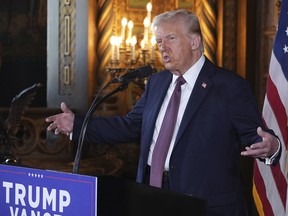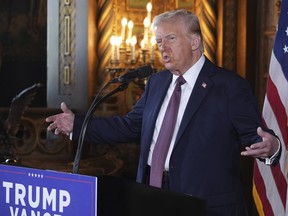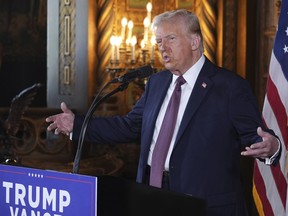Trump escalated his rhetoric about absorbing Canada into the United States, framing the move as a strategic shift shaped by economics rather than force. Speaking at a press conference at his Mar-a-Lago resort in Florida, the newly inaugurated or elected president laid out a controversial position that would see substantial tariffs placed on goods from Canada and Mexico. The tone was combative yet non-military in nature, insisting that the approach would be powered by economic leverage rather than armed action. He repeatedly suggested that removing or redrawing the border in a way that erases artificial boundaries could yield security and economic benefits, implying that U.S. protection of Canada would be a foundational element of this broader strategy. The remarks drew immediate attention for their stated aim to redefine continental trade relations and raise questions about the potential consequences for cross-border supply chains, prices, and national security justifications often used to justify more assertive policy moves.
This article reconstructs the central claims, the factual anchors, and the political signaling embedded in Trump’s remarks, while examining the broader context in which such proposals would unfold. It highlights the specific mechanisms proposed—tariffs and other economic measures—as tools for achieving strategic aims, even as it notes the complexity and fragility of North American trade relationships. The discussion also tracks the responses from Canadian officials, the political dynamics within Canada, and the potential spillover effects on markets, currency values, and energy flows that have long connected the two neighboring economies. The aim is to provide a comprehensive, in-depth reading of what was said, why it matters, and how it could alter assumptions about U.S.–Canada economic and strategic cooperation going forward.
Context and framing of the Canada question
In recent public remarks, the topic of Canada’s status vis-à-vis the United States resurfaced as a touchstone for broader debates about what constitutes national sovereignty, security guarantees, and economic self-determination in North America. The central framing put forward was not a call for military annexation but rather an insistence on “economic force” as the primary instrument to transform the relationship. The proposed logic rests on the idea that removing the current political boundary would yield improved national security outcomes and more efficient, integrated production networks. The argument includes a claim that the United States already bears a degree of implicit responsibility for Canada’s defense and security, a notion presented as a justification for closer alignment or even formal absorption under certain conditions. In presenting this position, the speaker invoked historical, logistical, and strategic considerations about cross-border infrastructure, energy flows, and manufacturing ecosystems that would be disrupted or reconfigured under a different model of governance.
The rhetorical emphasis on economics as the instrument of change mirrors a broader narrative about leverage in international trade. The proposed approach would pivot away from conventional diplomatic rhetoric toward explicit tariff-based pressure intended to compel policy shifts in Ottawa. By describing tariffs on Canadian goods as “substantial,” the speaker signaled a willingness to deploy financial penalties as a means to negotiate terms that would be favorable to U.S. economic and security priorities. The use of tariffs—if implemented on Canada and Mexico—would test the resilience of deeply integrated North American supply chains, including automotive, energy, and agricultural sectors that have benefited from decades of tariff-free or low-tariff trade under various regional agreements. This framing raises questions about who bears the immediate costs of such policies, how quickly those costs would manifest in consumer prices, and how governments might respond to avert broader economic turbulence.
The emphasis on redefining boundaries through economic policy also touches on national security logic. The speaker asserted that a more open, unified continental market could, paradoxically, underpin stronger protection against external threats. The claim that the United States “basically protects Canada” is presented as a justification for rethinking the current bilateral arrangement. Such framing invites readers to consider how security assurances, defense planning, and energy security are interwoven with trade arrangements. It also invites scrutiny of how border arrangements affect sovereignty, decision-making autonomy, and the distribution of costs and benefits across a densely integrated economic region. While the rhetoric is provocative, it enters a legal and constitutional terrain that would require extensive policy development, legislative action, and cross-border cooperation to translate into any concrete changes.
Tariffs, economic leverage, and the mechanics of change
A central component of the discourse centers on the potential deployment of tariffs as a structural instrument to compel policy shifts. The speaker indicated the intention to impose “substantial” tariffs on goods from Canada and Mexico, casting these measures as a strategic lever designed to influence trade terms, production patterns, and political calculations in Ottawa and Mexico City. The core idea behind this approach is to create economic pressure that would make the current arrangement untenable or less favorable to the United States, thereby accelerating negotiations around a new set of terms consistent with U.S. priorities. The proposal raises a spectrum of practical questions about tariff design, timing, enforcement mechanisms, and the potential for retaliation or escalation in the trading relationship.
From a policy design perspective, the move would require careful consideration of tariff rates, coverage, and the scope of products affected. Tariffs aimed at Canada and Mexico would not only influence consumer prices but could also alter investment decisions, production location choices, and the geographical distribution of manufacturing activity. Sectors with high interdependence in the continental supply chain, such as automotive manufacturing, aerospace components, and energy-related products, would be particularly vulnerable to disruption. The anticipated adjustments in these sectors would likely ripple through related industries—parts suppliers, logistics networks, and downstream distributors—raising the risk of price volatility and supply uncertainty in the near term.
The conversation about tariffs also intersects with the ongoing discussion of energy trade and resource-intensive sectors. The United States has long relied on Canada for substantial energy inputs, including crude oil, natural gas, and other commodities that feed into domestic energy production and industrial operations. A tariff regime could alter price signals across energy markets, potentially affecting the economics of oil distribution, refinery operations, and even electricity generation in some regions. While tariffs are framed as a tool for leveraging concessions, they also carry the risk of increasing costs for American consumers and businesses, complicating inflation dynamics and political feasibility in a volatile macroeconomic environment.
Another layer worth examining is the purported rationale behind tariff policy in this context. Proponents of such measures often argue that they rebalance deficits, correct perceived subsidies, and incentivize domestic production. In this case, the speaker alluded to the United States subsidizing Canada by a sizable amount, suggesting a figure around US$200 billion annually. If framed as a subsidy argument, the tariff design would be deployed to alter more than trade balances; it would seek to recalibrate the competitive landscape in favor of U.S.-based production and employment. However, making credible the claim of “subsidies” requires rigorous verification of fiscal flows, public programs, and cross-border economic benefits, which would be the subject of intense scrutiny in policy discussions, congressional hearings, and cross-border negotiations.
The potential use of tariffs also invites attention to the broader global trade architecture and legal constraints. Tariff actions on Canada and Mexico would intersect with regional trade commitments and longstanding agreements that govern how members are treated in terms of market access, dispute resolution, and anti-dumping measures. In a real-world setting, any tariff policy would necessitate careful legal justification, compliance with trade laws, and transparent, rule-based processes to minimize the risk of retaliatory actions or trade wars that could destabilize the region’s economic order. The political optics of such moves would be closely watched, as domestic constituencies would weigh the short-term costs against longer-term strategic aims. The complex calculus would involve estimating the macroeconomic impact, the political capital required to sustain such an initiative, and the likelihood of cross-border cooperation that could ultimately lead to a revised regional framework.
Energy, commodities, and the cross-border economic backbone
Canada’s role as a major energy and resource supplier to the United States places energy policy at the heart of the North American economic relationship. Canada has long been the United States’ leading external supplier of oil, a position that places the two economies in a tightly coupled dynamic where disruption in one country reverberates across energy markets and industrial activity. The economic interdependence is underscored by data indicating substantial Canadian oil sales to the U.S. and the deep integration of energy infrastructures, including pipelines, refineries, and downstream distribution networks. In addition to oil, Canada supplies uranium used by U.S. nuclear power plants and potash used as a critical fertilizer input for American agriculture. The combination of oil, uranium, and potash highlights the breadth of Canada’s export portfolio and its significance to sectors ranging from electricity generation to food production.
Against this backdrop, the currency markets respond to signaling about potential shifts in trade and policy direction. The Canadian dollar, often referred to as the loonie, is sensitive to political developments and trade policy expectations. When tariffs or renegotiation of terms are discussed at a high level, currency traders monitor potential implications for cross-border trade flows and the relative competitiveness of Canadian exports. In the period following discussions of tariffs and “economic force,” the loonie exhibited a degree of volatility, reflecting market anticipation of shifts in the trade landscape and the broader risk environment. The currency movements have tangible effects on pricing for imported goods, export competitiveness, and the cost structure of Canadian producers engaged in the U.S. market.
The conversation about export controls or taxes on specific Canadian commodities such as uranium, oil, and potash has also circulated as a potential policy response if a broader trade conflict were to intensify. Ottawa officials reportedly considered using export taxes as a possible retaliation instrument to preserve leverage in negotiations or to protect domestic interests in times of heightened tension. Such measures would need to balance the desire to safeguard critical domestic industries with the risk of provoking retaliatory measures or undermining the reliability of cross-border supply chains. The prospect of export taxes adds another layer of complexity to the policy landscape, given the economic importance of these commodities to U.S. energy security and agricultural productivity.
The macroeconomic implications extend beyond prices and trade balances. If tariff threats or export controls materialize, investment decisions in energy sectors, mining, and refining could be redirected, with potential implications for employment, regional development, and fiscal revenues in both countries. Regions that depend on cross-border energy trade would face a shifting landscape of economic opportunities and risks. Policymakers would need to consider not only short-term adjustments to price and supply but also longer-term strategies for energy security, diversification of supply sources, and resilience against shocks in a tightly integrated energy ecosystem.
Political reactions in Canada and the domestic landscape
Canada’s political leadership quickly responded to the provocative remarks, underscoring the seriousness with which such proposals are viewed in Ottawa. Prime Minister Justin Trudeau publicly rejected the notion that Canada could or should become part of the United States, stating unequivocally that there is “not a snowball’s chance in hell” that Canada would become a U.S. state. The reaction reflects a clear refutation of the notion of annexation, even as it recognizes the close economic and political ties that bind the two nations. Trudeau’s statement was complemented by supportive voices within his government who emphasized the importance of maintaining Canadian sovereignty while acknowledging the substantial mutual benefits that arise from Canada–U.S. collaboration in trade, security, and regional governance.
Public opinion data cited in the wake of these statements indicated strong resistance to such a change in status. More than eight out of ten Canadians reportedly opposed the idea, according to surveys conducted around the time of the remarks. The political dynamic within Canada includes a spectrum of responses: some officials and party leaders have publicly described the remarks as a joke or a provocation, while others have framed them as a cautionary reminder of the vulnerabilities inherent in cross-border relations and the importance of safeguarding Canada’s autonomy. The discourse also touches on the internal political strategies of major Canadian parties ahead of upcoming elections, with opposition leaders among the conservatives positioning themselves as steadfast defenders of national sovereignty and economic resilience.
Another dimension of the Canadian response centers on the diplomatic and public communications channels used to convey resolve in the face of threats. Foreign Minister Melanie Joly posted on social media that Canada will never back down in the face of threats, signaling both firmness and a commitment to maintaining a constructive approach to bilateral ties. While Trudeau himself announced his resignation in the near term—amid questions about the Liberal Party’s internal support and leadership viability—the broader diplomatic posture remained focused on safeguarding Canada’s national interests, sustaining cross-border cooperation, and navigating the economic interdependence that underpins the bilateral relationship. The resignation announcement adds a layer of domestic political uncertainty, potentially influencing how Canada approaches negotiations, policy handoffs, and long-term strategic planning.
On the Canadian political stage, figures such as Conservative Party Leader Pierre Poilievre have publicly asserted that Canada would never become a U.S. state. Polls and public commentary around this point suggest broad, cross-partisan consensus on the principle of Canadian sovereignty, even as parties debate the best path forward to ensure favorable economic outcomes and secure national interests in a highly integrated continental economy. In this context, the Canadian government faces the challenge of balancing assertive defense of sovereignty with pragmatic cooperation that supports jobs, energy security, and industrial prosperity. The policy dialogue within Canada thus shifts toward methods of protecting strategic sectors, exploring complementary trade agreements, and maintaining robust cross-border collaboration to preserve the benefits of proximity while resisting any move toward political absorption that could erode national autonomy.
Market signals, currency dynamics, and the broader economic narrative
In the wake of provocative statements and policy possibilities, currency markets and financial analysts scrutinize the implications for bilateral trade and macroeconomic stability. The Canadian dollar’s movement against the U.S. dollar reflects the perceived risk of policy shifts, changes in trade dynamics, and the potential for supply chain disruption. Traders consider questions about how tariffs, export controls, or other protectionist measures could alter the relative competitiveness of Canadian exports, influence import costs for U.S. consumers, and affect inflation and monetary policy dynamics in both countries. The near-term reaction in currency markets helps inform expectations about the resilience of cross-border trade and the degree of policy certainty that businesses can rely on when making investment decisions.
Amid the policy discourse, the broader economic picture includes ongoing debates about energy dependence, manufacturing competitiveness, and regional development. The cross-border supply chain has become deeply integrated across multiple sectors, including automotive manufacturing, aerospace, agriculture, and energy industries. The prospect of tariffs or export taxes introduces a scenario in which producers must navigate higher input costs, potential shifts in sourcing strategies, and possible relocation of production activities to optimize cost structures. Corporate decision-makers would likely assess scenarios for reconfiguring supply chains, adjusting inventory management, and negotiating new terms with suppliers in light of evolving trade conditions.
Public messaging from political leaders and policymakers emphasizes resilience and adaptability in the face of potential disruptions. The business community, including manufacturers, energy firms, and agricultural players, has to weigh the upside of closer alignment with U.S. markets against the downside risk of price volatility and demand fluctuations that could accompany tariff regimes. The emphasis on economic force as a policy tool would necessitate contingency planning, scenario analysis, and sustained engagement with international partners to minimize adverse effects on jobs and long-term growth. In this context, the role of central banks and fiscal authorities becomes central to maintaining macroeconomic stability while policy frameworks adapt to a changing continental trade landscape.
Policy trajectories, risk assessment, and possible futures
Looking ahead, policymakers face a range of possible trajectories in response to these provocations. One path contemplates a rapid, tariff-first approach intended to force concessions within a tight political window. This route would require rapid legislative action, executive operationalization, and a coordinated diplomatic effort to manage any retaliation or escalation by Canada and other partners. A second path envisions a more gradual approach, coupling tariff threats with negotiation channels, oversight mechanisms, and safeguards designed to protect critical supply chains while pursuing a new framework for economic integration on terms favorable to U.S. strategic objectives. A third path could involve reinforcing existing cooperative structures that enable secure trade, energy collaboration, and mutual defense arrangements, thereby avoiding an abrupt or destabilizing shift in the bilateral relationship.
Each trajectory carries distinct risks and potential benefits. The tariff-first strategy could deliver short-term leverage but at the cost of inflaming tensions, raising inflationary pressures, and triggering countermeasures that may reduce the efficiency of North American markets. The gradual, negotiation-oriented approach might preserve stability and preserve cross-border collaboration, yet it could prolong uncertainty and delay the realization of any contemplated gains from a redefined partnership. The cooperative pathway, while the most stability-oriented, would require tempered expectations about what constitutes acceptable terms and the scope of mutual commitments. In all cases, the dynamics of domestic politics in both countries will shape the pace and direction of policy development, with leadership changes and public opinion exerting important influence over the negotiation calculus.
For Canadian policymakers and private-sector stakeholders, the primary concerns center on preserving sovereignty, maintaining market access, and safeguarding strategic industries that underpin national prosperity and regional employment. In particular, energy, mining, and agricultural sectors stand at the center of cross-border trade discussions, given their critical roles in energy security and agricultural productivity. The possibility of export taxes or policy responses would be evaluated not only for immediate economic impact but also for longer-term implications on investment confidence, technology transfer, and the attractiveness of Canada as a supplier to diversified markets beyond the United States. The cross-border nature of these industries implies that any policy shift would need to be coordinated with multiple stakeholders, including provincial authorities, industry associations, labor unions, and financial institutions, to manage transitional costs and to preserve competitiveness in a global context.
Within the United States, the policy debate would likely revolve around the alignment of tariff measures with broader strategic objectives. Lawmakers would scrutinize the fiscal and distributive impacts of tariff policies, assess their compatibility with existing trade obligations, and consider the domestic political ramifications of pursuing a high-stakes policy. The role of economists, legal scholars, and industry experts would be crucial in evaluating the net effects on job creation, consumer prices, and the long-run health of supply chains that underpin the manufacturing base. The cross-border nature of the discussion also invites a renewed emphasis on data-driven policy analysis, transparent communication with the public, and the development of contingency plans to manage potential disruptions in critical sectors.
The road ahead: diplomacy, preparation, and resilience
Regardless of the exact policy path chosen, the pressing need is to prepare for a range of possible outcomes that could unfold over months and years. Businesses and governments alike should strengthen risk assessment frameworks, diversify supply sources where feasible, and bolster contingency planning to weather potential shocks in trade policy and energy markets. The cross-border relationship remains a cornerstone of North American economic stability, making it essential for policymakers, industry leaders, and energy providers to engage in proactive dialogue aimed at safeguarding jobs, securing energy reliability, and sustaining cooperative governance arrangements that reflect shared interests.
In practical terms, this means continuing to monitor tariff developments, evaluating the resilience of essential supply chains, and pursuing targeted investment in sectors that offer the greatest potential for mutual benefit. It also means reinforcing border infrastructure, modernizing regulatory harmonization where possible, and fostering collaborative security and defense planning that respects the sovereignty of each nation while recognizing the mutual benefits of a stable, integrated continental economy. The conversation must remain grounded in facts, with careful analysis of the economic costs and benefits that would accompany any significant policy shift, and a commitment to transparent, evidence-based decision-making.
Ultimately, the North American partnership has demonstrated the capacity to adapt through periods of tension and renegotiation. The events surrounding the Canada question—whether they culminate in a new framework, a recalibrated set of trade terms, or a reaffirmation of existing arrangements—will shape the trajectory of the region for years to come. Stakeholders on both sides of the border should approach the situation with a focus on practical outcomes: preserving jobs, maintaining energy security, and ensuring that any policy changes contribute to long-term prosperity rather than short-term disruption. In an environment of high stakes and rapid change, resilience and collaboration remain the most reliable tools for navigating forward.
Conclusion
In this moment of heightened rhetoric and strategic ambiguity, the prospect of redefining the U.S.–Canada relationship through economic force rather than military means stands as a provocative and consequential proposition. The core ideas center on applying substantial tariffs and other economic tools to incentivize a rethinking of sovereignty, trade terms, and cross-border governance. The discussion underscores the importance of energy and key commodities in shaping bilateral dynamics, given Canada’s role as a major supplier of oil, uranium, and potash to the United States. It also highlights the political and public-reaction dimensions inside Canada, where sovereignty and leadership considerations dominate the discourse and the political landscape evolves toward leadership changes and strategic recalibration.
As both nations contemplate possible futures, the emphasis should be on robust risk assessment, transparent policy design, and sustained dialogue that can translate into concrete, beneficial outcomes for workers, communities, and industries across North America. Whether the path chosen is tariff-centered, negotiation-driven, or grounded in reinforced cooperation, the overarching objective must be to safeguard stability, protect strategic interests, and sustain the long-standing economic and security ties that have defined the region for decades. The road ahead will require careful navigation of domestic politics, international legal considerations, and the practical realities of a deeply integrated continental economy. The outcome will hinge on the ability of leaders to balance sovereignty with shared interests, manage the costs and benefits of any policy shift, and maintain the confidence of businesses, workers, and consumers who rely on a predictable, resilient cross-border system.




